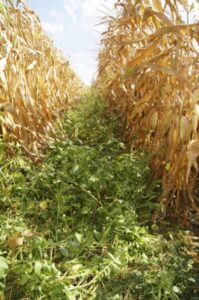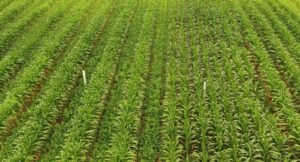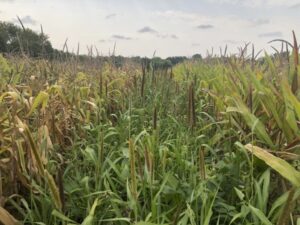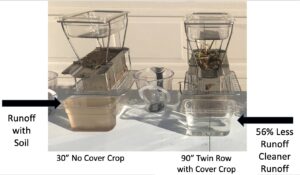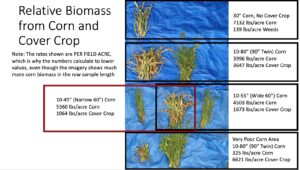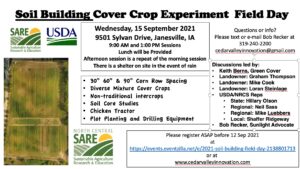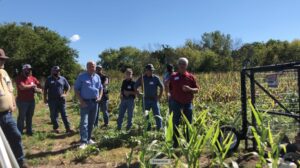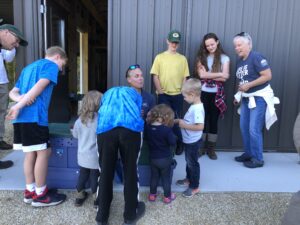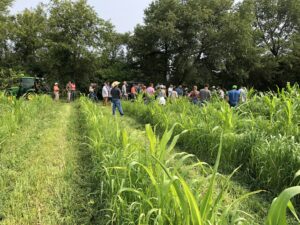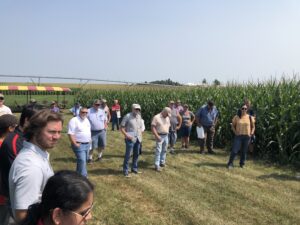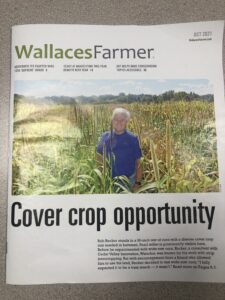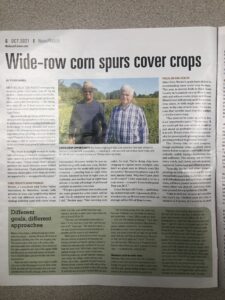Final report for FNC21-1297
Project Information
I have been doing on-farm research on a full time basis since retiring from a corporate job in 2008. I have developed excellent relationships with commercial growers who collaborate with me to conduct field-scale plots within their operations, but evaluating the alternative practices that I propose. I have acquired a full set of planting, seeding, measuring and harvesting equipment. My largest season has been conducting over 200 acres of experiments on several commercial farms. This is a bit larger than my normal preference, since I tend to favor more radical departures from traditional practices. My focus has been grain crops, with my special interest in leveraging sunlight to maximize yield. In the past two years, I have pivoted to a focus on cover crops and soil health because they are compatible-even to the extent of being required-with wide row grain crops to leverage sunlight. The secondary benefits of reduced runoff, lower nitrogen requirements, and biodiversity on our landscapes are all very valuable. I accept the challenge to package these practices in a manner that is useful and productive to the commercial grower's Triple Bottom Line (1. Profitability, 2. Leave the farm in better shape than you got it, and; 3. Grow food, fuel, and fiber for a growing population). I have a keen interest in finding a way to encourage re-introduction of livestock on the landscapes, but that is a huge challenge. It is a longer term goal for me.
There are many areas in farms where the soils are degraded due to continuous tillage, exposed bare soil, erosion, etc. This project intends to demonstrate methods and processes to improve soil health while still producing a cash crop of corn and/or soybeans. The corn will be planted in wide rows to allow sunlight to reach the surface where the cover crops, companion crops, or alternate high value crops grow. Previous work by myself and others has shown nearly equivalent corn yield in wide rows with equivalent field population. This project will have (5) 40 ft wide strips with alternate treatments: 1) "Do Nothing Different" - a baseline of typical current large scale practices, 2) A multi-species cover crop with species selected for maximum soil health improvement in a short time, 3) A simple cover crop species as a typical grower would begin to adopt cover crops, 4) A pollinator and beneficial plants per the STRIPS process dictated by Iowa State University, 5) A high value crop specified by each grower. Results will be shared with the public in field days with soil pits to show differences and improvement in roots and soil texture.
- Plant, document, and measure the above ground growth of a variety of cover crops in wide row corn plots compared to traditional practices.
- Measure the soil health changes with the Haney Soil Health methods due to the 5 alternate treatments of the plots.
- Conduct a late summer field day on at least one of the sites, including a soil pit to demonstrate the below ground impact of the alternate treatments.
- Duplicate the treatments, observations, measurements, and public outreach in 2022 as in 2021.
Cooperators
- - Producer
- - Producer
- - Producer
Research
The core of the project is a set of strips, each approximately 40 ft wide by 500 ft long. Each strip has 6 twin row pairs. The plot test variable is the cover/companion crop between the corn rows. The metric of success is the change in soil properties, including soil health metrics, especially in the lighter soil areas. The corn yield will be measured and all input costs recorded for economic analysis. This protocol will be replicated at each of the four sites. One of the sites will be selected for a late September field day when corn yield can be estimated, and subsurface soil properties can be displayed in a soil pit. The same strip arrangement will be repeated in 2022, and the goal is to extend the project for a total of five seasons. A key element to increase the effectiveness of the display is the "Do Nothing" strip which will serve as a baseline for comparison purposes. This will increase the confidence in the impact of the test plot variables significantly. On-the-ground and drone imagery will be very useful for showing the development of the various alternative cover crops thru the season, in light of variable soil conditions. The four locations provide a margin of safety against extreme weather conditions and increase the learning in alternate soil conditions. All corn and cover crops will be planted and harvested by Bob Recker, the principal investigator.

Soil and Water Health Focus.
This was an interesting and informative year! Because the focus is building soil health, our primary efforts were centered on locating plots with marginal soil and then pursuing cover crop treatments that encouraged soil improvements, even at the expense of the cash crop (corn). The images and video below show our results.
Rainfall Runoff Reduction: The Bottom Line is that our aggressive cover crop treatment reduced water runoff by 56%. The link below shows more detail on the rainfall runoff measurement from soil samples in this plot.
Biomass Production with Aggressive Cover Crops.
In spite of poor corn yield because of our "Cold Turkey" approach to moving quickly towards regenerative organic farming and emphasis on soil building, we had outstanding performance of the complex mix of cover crops. The image below shows the relative amount of above ground biomass for the different treatments.
The link below is a PowerPoint file showing the difference in relative biomass from the Cover Crop and the Cash Crop in different locations in the plot field.
Soil Property Measurements
We also made a number of soil sample measurements, knowing that any change would take some time. However, we were delighted to see an increase in soil organic matter as reported by two different soil laboratories from samples taken from two nearby treatments. We recorded a 0.2 & 0.3% increase in soil organic matter in just one season. This exceeded our expectations. We intend to perform more measurements like this next year to increase our statistical confidence in the result.
There is more detail and imagery in the PowerPoint file below:
Video Overview Tour of Plot
The video below is a narrated drone tour of one of the plots after our field day, and just prior to harvest. The file is large, but I recommend taking the 11 minutes to watch it. Because the file size is large, it is a link to a dropbox file which you can download. PLEASE NOTE: Some of you may have download restrictions on your work computers. In that case, I recommend using a personal account access. Here is a link to the video file:
FNC21-1297 Bob Recker Video field tour
Educational & Outreach Activities
Participation Summary:
A field day was held on 30 September 2022 on Mike Cook's field. This is the flier that was used to promote that meeting
This field day was different than the 2021 version in that there was a much better corn crop due to better weather, better nutrient management on this non-organic plot (unlike the focus plot in 2021) However, due to a pretty aggressive termination of last season's cover crop, the newly seeded cover crop did not perform as dramatically as last years. I don't think this is a question of corn vs. cover crop (not "Pick one!") I have prepared a Power Point file that gives an overview of the plot, plus detailed single plant corn yield comparisons for the various row spacing. This process was very well received at the field day, and builds on my past practices.
This field day was recorded has been placed on my YouTube Channel under "Bob Recker"
Here is a link to the playlist, which includes about 100 minutes of content in 11 different sessions, covering individual corn plant yield, soil health observations, and discussions about utilization of the "Opportunity Space" between the wide corn rows:
https://youtube.com/playlist?list=PLhBXo4t4DXerTnnN2UCehttDWzSjg4N_k
I have also prepared a PowerPoint file with data and reference information from the single plant layout work discussed in the video series.
This is the flier for our 15 Sep 2021 Field Day, in PowerPoint format. It was made available in paper, electronic, and word-of-mouth format. It was posted on facebook, and on my website at www.cedarvalleyinnovation.com
There were approximately 85 persons registered for the meeting, which was held in a morning and afternoon format. Attendees included growers, USDA staff and employees, and members of the public. The file below is a set of handouts and posted "wall info" at our field day to show the plot layout, and the configuration of the various replicated plots and the cover crop species included in them.
2021-09-15 Field Day Wall Info.2
Here is an image from one of our 15 September field day stations with a mobile "chicken tractor" for grazing chickens and sheep.
Several weeks after the field day, we did a repeat of the field day, but focused on the non-farming neighbors of our plot area, with a focus on their children. There is a photo below.
Thru the summer, I have had the opportunity to share the story of our work and progress in several field days, one of which was held at West Union, IA on one of my plot sites, and hosted by The Rodale Institute. A photo is included below:
I used my plot equipment to plant cover crops in wide corn rows at the Iowa State University Northeast Experimental Station at Nashua, IA. There was a summer field day on 03 August
and a fall field day on 11 November 2021, both of which featured the wide row corn with cover crop planted by me. These meetings gave my work more exposure to the public, and gained some credibility due to the association with Iowa State University.
Ag magazine article: Wallaces Farmer
23 Jan 2022 Update: YouTube visuals
I have updated my YouTube Channel ID= BobRecker
ALL of the video material from the field day is included in addition to several other items on rainfall simulator quantitive results, a drone flight overview of the field just prior to harvest. There is a Playlist named 15 Sep 2021 Field day materials that has 14 short video segments for a total of 140 minutes of material. This should be viewable by anyone in the public. This format will be used for additional updates in the 2022 season.
Learning Outcomes
We took advantage of the knowledge of cover crops in a collaboration with Keith Berns of Green Cover in Bladen, Nebraska. On his recommendation, we planted a diverse mix of cover crops with 14 different species in the mix.
We also made the unilateral decision to focus almost entirely on building soil health on the most marginal plot spaces. To that end, we did not apply any synthetic fertilizer to the corn. We refer to this as "Going Cold Turkey" into regenerative agriculture practices. We were able to do this because our plots were relatively small, and loss of income for a season or two due to this approach would be tolerable.
This was a good decision for growing soil health. It was a bad decision for continuing profitable cash crop corn growth. We have been very transparent with this learning, both from the great cover crop results, reduced water runoff, and better soil organic matter (all discussed above) as well as the dismal corn yield. Thus we say, "Don't do this on your farm" in such an aggressive fashion if continued profitability is a key goal. However, the dramatic results we have seen with the cover crop vigor in the wide corn rows is expected even with a fully fertilized corn crop.
For next season (2022) we will modify the approach to better fit the goals of the individual grower cooperators. In one case, (Thompson) the one most discussed above, we are continuing the aggressive move to organic farming and regenerative agriculture. We will need to locate and apply organic fertility packages to help the cash crop, but which are not offensive to the plot's neighbors. On a second plot (Mike Cook) we will return to a modest amount of synthetic nitrogen and adopt a more transitional approach to regenerative agriculture. We will continue the wide rows with aggressive cover crops. On the third plot (Steinlage) we will continue with organic practices, and are still developing specific plans. Wide rows will be a key common denominator with full season cover/companion crops on all our plots going forward.
2022 Update:
The cover crop effectiveness on the Graham Thompson Plot has continued, and we are continuing the aggressive "Cold Turkey" transition to Organic Farming practices. For this primary reason, and several other contributing, we did not harvest a corn crop at the Thompson plot. On the other hand, we made the changes as planned at the end of last season. As a result, we had a much more successful corn crop experience at the Mike Cook plot, which is the focus of this update. Executive Summary: We observed and recorded excellent performance of wide row corn compared to traditional narrow row corn, which is the core of all this work. There is much more detail in the PowerPoint file linked in the section below.
Project Outcomes
There are a number of growers and landowners who have taken a great interest in my work. It is intriguing to them because it is so different from their traditional practices. This is similar to the process I used when I accidentally discovered the potential with 60 inch rows in 2017. Since that time, there are a number of growers experimenting with this process on their own farms, adapted to their business model and practices. I expect the same process to repeat with the wider rows and aggressive cover crops than have become my signature practice in the last year.
I am in discussions with several additional growers and have applied for an extended grant to allow me to establish demonstration plots on growers' own farms to observe the benefits we have seen, measured, and shared on my plots this season. I believe and openly share that it is very important for a grower to do these kinds of experiments on a small scale, but ON THEIR OWN LAND, rather than just attending field days and conferences, etc. My goal is to coach them in the new information and practices they need, and only do the planting, crop care, measurement, and harvest if they are unable to do that work. They will learn best by their own hands-on approach.
I will be putting the materials above and a much larger set of field day recorded videos on my website at www.cedarvalleyinnovation.com. in the weeks ahead. It was not feasible to include them here because of file size limits, etc. I expect them to be widely viewed and shared in various social media venues.
This is been an amazing project, and an amazing year. I look forward to major new learning next season, and even more so to sharing the work in field days, one-on-one field visits, and leveraging ag media as much as possible. Thank you for supporting this learning for all of us. It is a Good Thing.
December 2022 update
This has been an amazing year; our major learning and demonstration has pivoted to wide row corn to enable the outstanding cover crop response we observed last season. Our wide row corn plots were productive, and demonstrated potential to deliver one of the key drivers of this work: an open, productive environment for soil building cover crops and revenue building companion crops. More work and more documentation is certainly needed, but there is promise.
I fully intend to expand the work we have done to other plots on growers' farms as quickly as possible. The learning we have experienced this year will increase the probability of success and grower adoption in their own operations.
I am most willing to coach others in duplicating and improving the work I have done. That is an ultimate success metric for me. However, I look forward to continuing this work on an expanded scale, and am hopeful that SARE will be supportive of that.
This year, I have learned that the SARE brand is powerful to many early adopter farmers, and when I tell them I am operating under a SARE grant, it seems to improve their receptivity. I hope to honor the SARE brand and integrity, and improve it's standing in the ag community by delivering the most professional results feasible with my limited resources. Your assistance is very much appreciated.
Bob Recker
14 December 2021
December 2022 update
My social media skills are building, and still have far to go, but I remain convinced that this is a very powerful tool for reaching out to a wide, diverse population of potential adopters of these changes. We have good, data drive preliminary results; I remain and am increasingly committed to continuing the work; outreach will be an important part of that, but it must be based on hard data where possible.
The support of SARE has been a pivotal part of my effectiveness to this point; I hope to continue the relationship in the future.
Bob Recker
11 December 2022
